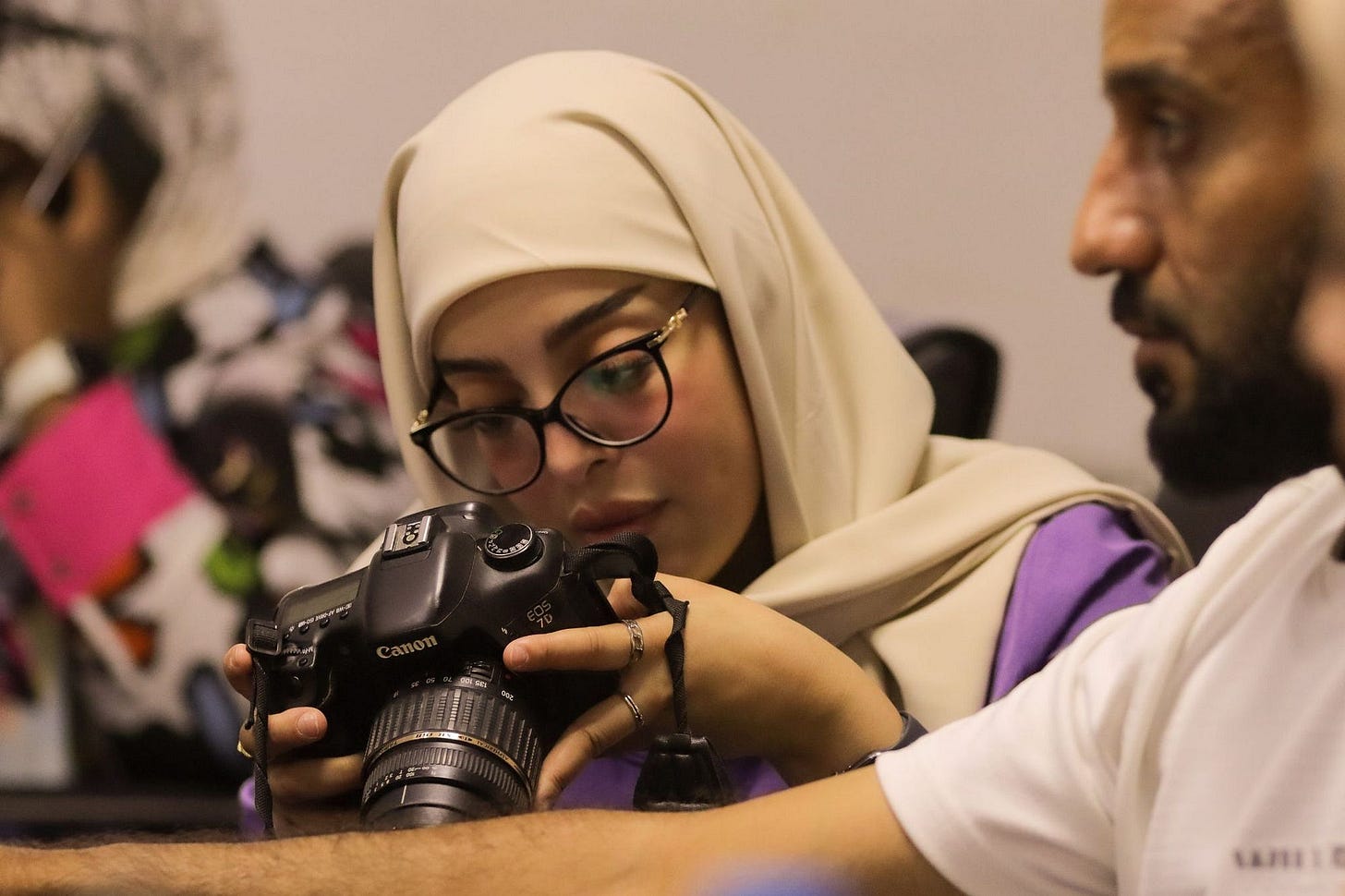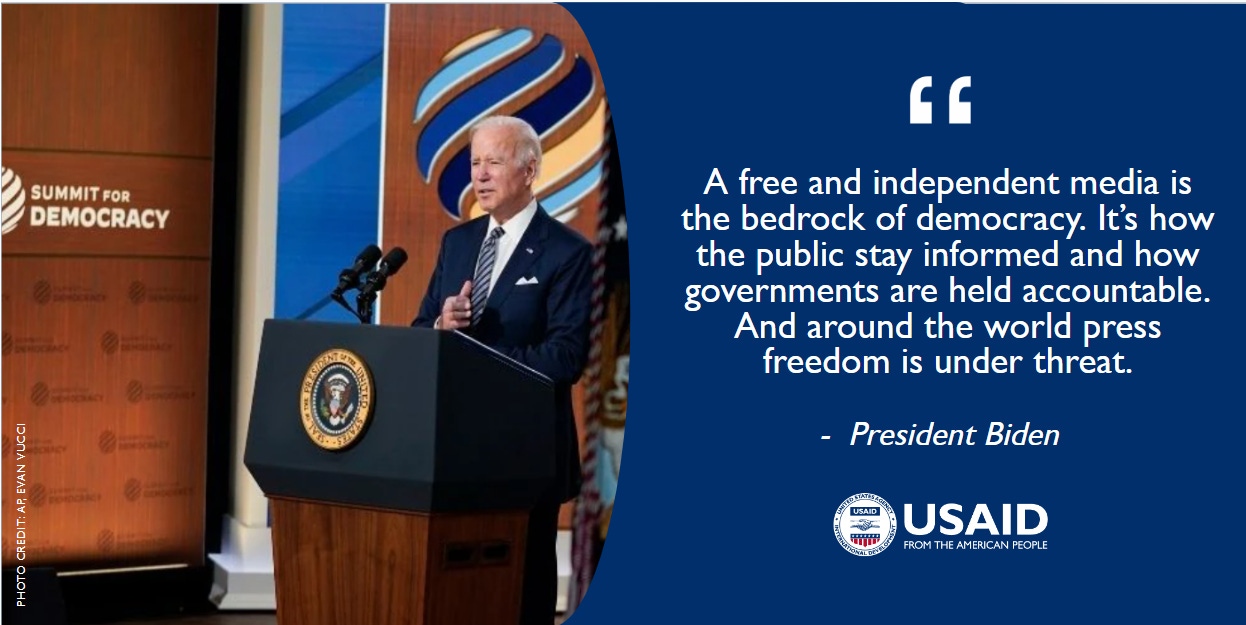Before Trump Takes it Down, Here's USAID Explaining Its Support of Journalism in Repressive Places
Amid Trump and Musk’s “everything everywhere all at once” blitz of assaults, here’s one snapshot on the impact on America’s efforts, mostly through the now-frozen U.S. Agency for International Development, to foster effective journalism in repressive countries. Since the weekend, X has been thick with echoes of this Musk post.
This led me to a Jon Allsop story at Columbia Journalism Review: USAID and the Media in a ‘Time of Monsters’.
After reviewing the news about the Musk team and the agency, Allsop has a section on the immediate consequences of the freeze in funds:
[T]he new administration’s approach to USAID has had sharp consequences all over the world—after taking office, Trump signed an order freezing virtually all American aid spending for ninety days, grinding dependent humanitarian operations to an immediate halt across a dizzying array of different project areas. Journalists have been among those affected: according to Reporters Without Borders (RSF), the aid freeze appears to have put a hold on $268 million that was earmarked to fund “independent media and the free flow of information” this year. In the recent past, USAID had boasted of supporting more than six thousand journalists, around seven hundred independent newsrooms, and nearly three hundred media-focused civil society groups in thirty or so countries—and yet, RSF notes, the full impact of the freeze is hard to measure, since many recipients are “hesitant to draw attention for fear of risking long-term funding or coming under political attacks.”
News outlets that have been exiled from Iran and Belarus did tell RSF, under the cover of anonymity, that the freeze has forced them to take drastic measures just to survive, while DataCameroon, an investigative site, said that it had to suspend projects linked to journalist safety and upcoming elections in the country. RSF also noted the harsh effect on journalism in Ukraine, where 90 percent of news organizations rely on USAID funding, some very heavily; writing last week, Olga Rudenko, the editor in chief of the Kyiv Independent (which has received USAID grants in the past but doesn’t currently), claimed that the freeze “has caused harm to independent Ukrainian journalism on par with the COVID-19 pandemic and the onset of Russia’s full-scale war,” and could soon surpass both in severity if not reversed. There have been reports, too, of concrete effects on journalism from Moldova, Cambodia, and Myanmar; writing in the Indian publication Scroll, Nandita Haksar, the coauthor of a new book on the prominent Burmese newsroom Mizzima, reported that the freeze has plunged that outlet into uncertainty exactly four years on from a brutal coup that forced Myanmar’s independent media into exile or underground. (I reported on the impact of the coup for a forthcoming book that I’ve written about journalism, and found that it made the country’s surviving independent outlets highly dependent on international donor funding.)
He quotes from a February 2024 Medium post by USAID on its journalism work that has survived the website shutdowns.
I’m reposting that piece below just in case it gets taken down.
I have plenty of questions about U.S. government funding for journalism, which is ideally a completely independent enterprise. But the abrupt freeze and prospects of full-bore budget cuts under Trump do pose deep dangers.
I’ve trimmed off the opening of the February 2024 USAID post on Medium, which goofily was built around Journalist Barbie. Let’s cut to the core:
Violence, harassment, repression, and censorship against journalists is at record highs, with the Committee to Protect Journalists recording the highest (2022) and second-highest (2023) numbers of journalists imprisoned since it started tracking this figure 30 years ago. Last year also saw a high number of deaths of journalists covering the Ukraine and Gaza wars, and a sharp rise in killings in Latin America where reporting on organized crime, corruption, and the environment poses significant risks.
Responding to The Threat
When authoritarian and other repressive actors seek to silence expression, they do so to divide citizens, undermine their faith and trust in institutions, and make them question whether democracy can deliver for them.
Whether traditional techniques — attacking journalists, jailing editors, or putting censorship statutes on the books — or new takes like poisoning the information space or shutting down the internet, the intent is to silence dissent, or even just create uncertainty or cynicism.
As worst practices are shared, we see corruption weaponized, truthful narratives purposely distorted, and technologies put to work against reporters in Sudan, Myanmar, Belarus, Kyrgyzstan, and so many other places. Accelerating this trend was the COVID-19 pandemic, when uncertainty and global economic disruption opened the path for increased democratic erosion and closing civic space, putting even more pressure on independent media.

Supporting independent media has been part of USAID’s democracy and governance assistance efforts since the 1980s. The U.S. government is now the largest public donor to independent media development globally.
Based on decades of evolving research, testing, and learning, USAID has expanded its understanding of the multiple intersecting threats media practitioners face — legal, physical, economic, and digital — and how necessary it is to work from many sides to build and reinforce media sectors that are as resilient as possible against the forces that would seek to shut them down.
New Initiatives to Advance Free and Independent Media
Amajor demonstration of this approach comes through USAID’s Summit for Democracy commitments, a series of initiatives to address these threats and advance free and independent media.
The first one is the Media Viability Accelerator (MVA), which was announced at the first Summit for Democracy in December 2021. The goal of the MVA is to preserve fact-based news and information media by providing access to the data they need to build strategies to survive, thrive, adapt, and grow as businesses. Through a public-private partnership with USAID, Microsoft, and Internews, MVA is a unique data platform using artificial intelligence and other digital tools to enable media outlets to better understand markets, audiences, and strategies that will maximize their odds of profitability.
Second, USAID’s $20 million contribution to the International Fund for Public Interest Media (IFPIM) is helping to boost global support through grants to develop and sustain a wide range of independent news organizations. To date, IFPIM has committed nearly $9 million through 32 grants across 16 countries to media outlets in urgent need of financial assistance and to strengthen their long-term sustainability. USAID’s initial seed funding has leveraged an additional $30 million from 15 governments, philanthropies, and corporate entities.
The third initiative is Reporters Shield, an innovative program that helps protect investigative media outlets and civil society organizations from strategic litigation against public participation lawsuits, or other legal threats meant to silence their reporting. Prior to the launch of Reporters Shield, such help was inconsistent, ad hoc, reactive, and, often, expensive.
USAID Administrator Samantha Power launched the next phase of USAID’s Reporters Shield, at the United Nations Headquarters last World Press Freedom Day on May 3. Reporters Shield is now providing legal support services and capacity development for 12 media outlets and civil society organizations doing investigative reporting, with more than 100 applications still under review during the launch phase alone. Additional phases will be opening in spring and summer.

Ensuring Trustworthy Information
Although these three innovations directly benefit journalists and media organizations, they are ultimately meant to ensure that all of us have sources of trustworthy information.
They also complement other USAID programs that equip journalists and their allies to protect themselves from attacks online and offline, strengthen investigative journalism networks, advance freedom of expression, and amplify citizen voices and government response.
At the third Summit for Democracy from March 2024, and hosted by South Korea, USAID will share progress on these initiatives that underline its commitment to supporting journalists and their allies to build robust, resilient media sectors — and look ahead with like-minded governments and development agencies to the ongoing challenge of protecting the fundamental freedom of information access against an ever evolving set of threats.
Reporters have enough work to do with serving as watchdogs and, at times, bulldogs. To paraphrase Dua Lipa in Barbie, they can take the heat, baby, best believe that’s the moment they shine. In doing so, however, as Administrator Power noted in her World Press Freedom Day speech in May 2023, journalists shouldn’t have to deal with bankruptcy, bailiffs, or bullets.
About the Author
Shannon Maguire is the Senior Media Advisor in USAID’s Bureau for Europe and Eurasia’s Technical Support Office in the Democracy and Governance Division.











A good time to ask about other global organizations that might take on this worthy agenda.